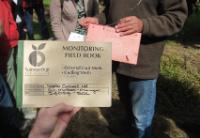ENV IPMHUB › IPM Guidelines
IPM Guidelines
 |
IPM guidelines for various sectors and crops exist in many OECD countries. The guidelines provide a set of principles or standards for the integrated crop protection, including preventive and cultural measures and the direct control of pests, disease and weeds in different agricultural farming systems as well in non-agricultural sectors. Depending on the country or region IPM guidelines can be voluntary or mandatory and /or part of integrated production schemes. |
| © JKI/SDS |
The following main steps can be considered as typical for an IPM approach (source FAO).
(1) Prevention and/or suppression of harmful organisms. This should be achieved or supported among other options especially by:
- crop rotation; inter-cropping
- use of adequate cultivation techniques (e.g., stale seedbed technique, sowing dates and densities, under-sowing, conservation tillage, pruning and direct sowing)
- where appropriate, use of pest resistant/tolerant cultivars and standard/certified seed and planting material
- balanced soil fertility and water management
- prevent spreading of harmful organisms by field sanitation and hygiene measures (e.g., by removal of affected plants or plant parts, regular cleansing of machinery and equipment)
- protection and enhancement of important beneficial organisms, e.g. by the utilization of ecological infrastructures inside and outside production sites.
(2) Harmful organisms must be monitored with adequate methods and tools, where available. Such adequate tools should include observations in the field and where feasible warning, forecasting and early diagnosis systems (e.g. traps).
(3) Based on the results of the monitoring it is decided whether and when to use what pest management inputs. Sustainable biological, physical and other non-chemical methods must be given priority over chemical methods if they provide satisfactory pest control.
(4) Pesticides should only be applied when threshold values indicate that pesticide use is justified.
(5) The pesticides applied shall be as specific as possible for the target and shall have the least side effects on human health, non-target organisms and the environment, while their use should be kept at minimum levels, e.g. by partial applications.
(6) Monitor the success of the applied pest management measures.
Related Documents

